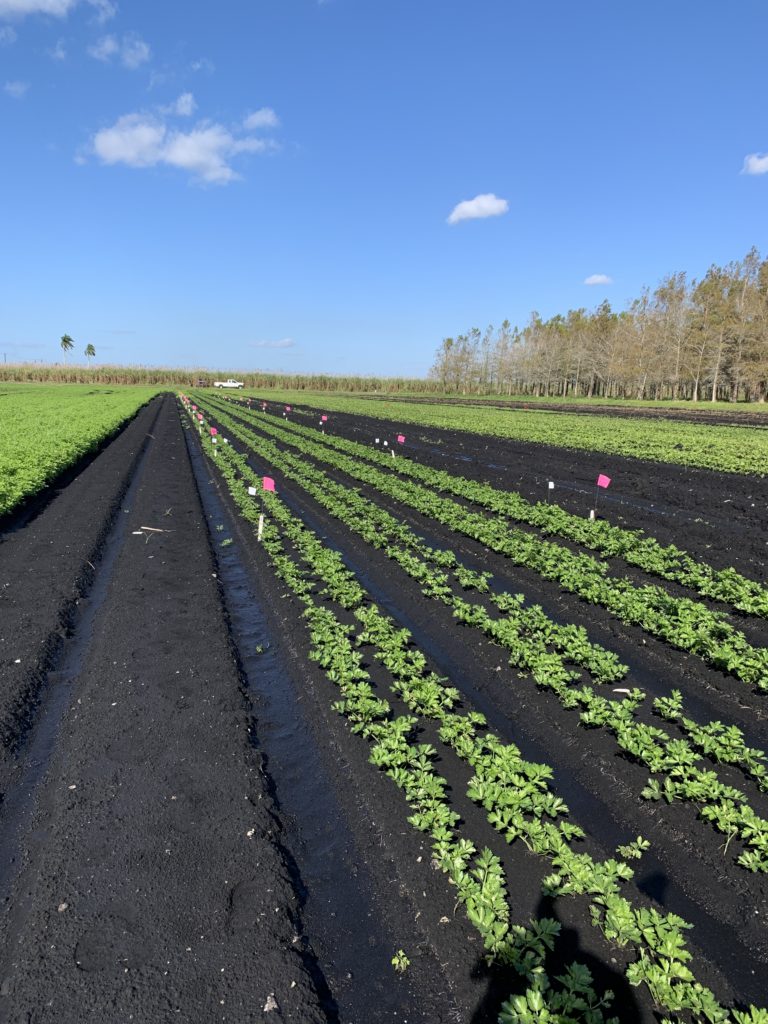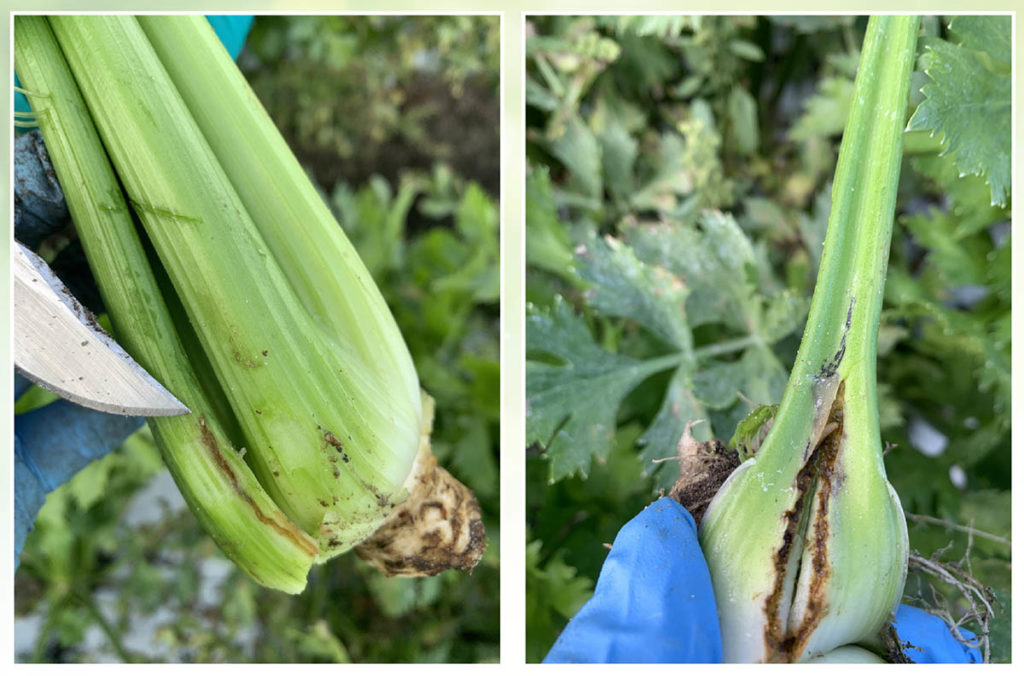By Julien Beuzelin and Anna Mészáros
Florida produces apiaceous crops, which include celery, parsley, cilantro, dill and carrots, from the fall to the spring. The production of these vegetables and herbs complements the production from the West Coast to supply national markets, playing a key role during the winter, particularly when unfavorable environmental conditions decrease production in California. The major production region for celery in Florida is the Everglades Agricultural Area (EAA) in the southern part of the state. Other apiaceous crops are produced in Florida’s southern and central areas, and a substantial proportion of carrot production has expanded into northern Florida.

Photo by A. Mészáros, UF/IFAS
In 2020 and 2021, celery and parsley producers in the EAA reported widespread and unusual insect injury in conventional and organic fields. This injury was caused by weevil larvae tunneling into plant petioles, crowns and roots. In celery, injury has required removal of damaged petioles, also known as stalks, at harvest. In parsley, injury has caused plant stunting and sometimes death because of pathogen infections facilitated by weevil injury.
To respond to this new insect pest, University of Florida Institute of Food and Agricultural Sciences (UF/IFAS) Everglades Research and Education Center (EREC) entomologists and the Palm Beach County Extension agent for commercial vegetable production initiated a research and Extension program in 2021.
Farm visits and field collections were conducted in the EAA and surrounding region in Palm Beach and Hendry counties in 2021 and 2022. Weevil larvae collected on celery and parsley plants were reared in the laboratory on celery plants to obtain adults, which were used for species identification. Weevil adult specimens were identified by taxonomists of the Florida Department of Agriculture and Customer Services Division of Plant Industry and by an international weevil specialist with the Canadian Museum of Nature. The weevil was found to be Listronotus sparsus, which is a widespread species that had never been reported as a crop pest.
Weevil larvae were also observed feeding on dill and carrots. The species infesting these two apiaceous crops has not been identified, but L. sparsus is suspected. These observations suggest that L. sparsus exhibits behavior comparable to that of carrot weevils, L. oregonensis and L. texanus, which are serious pests of apiaceous crops in the Great Lakes region and Texas, respectively. Thus, L. sparsus likely represents a significant threat to most apiaceous crops in Florida. The crop host range needs to be confirmed.
The cause of the weevil’s emergence as a new pest in Florida is unknown and might be associated with changes in production practices (including insecticides), insect biology (host plant shift) or weather patterns.

Photo by A. Mészáros, UF/IFAS
BUG BEHAVIOR
Observation of sentinel celery plots at the UF/IFAS EREC showed that weevil females insert their eggs under the surface of plant petioles. Larvae feed within petioles and move down to the crown. Thus, larvae are protected from insecticide applications. The weevil infests celery plants of all ages, and the life cycle of the pest generation takes six to eight weeks.
Light trapping on a commercial farm showed that weevils are attracted to lights and are relatively good fliers. Thus, light traps might be used to monitor adult populations. Adults appear to have the ability to move among fields on the farm.
INSECTICIDE TRIALS
Multiple applications of the carbamate insecticide oxamyl (Vydate L) have been used to manage the weevil in celery because the insecticide is registered for control of the “carrot weevil” in the crop. However, oxamyl is hazardous, relatively expensive and needs to be incorporated into the soil using water or mechanical means. Oxamyl is not registered for use on parsley.
A field trial at the UF/IFAS EREC in 2022 confirmed that oxamyl reduced injury and infestations in celery. Results also suggested that foliar applications of the reduced-risk insecticides cyantraniliprole (Exirel, registered for use on apiaceous crops) and novaluron (Rimon, not registered for use on apiaceous crops) might control the weevil at the highest field rates.
A follow-up on-farm trial on parsley showed that foliar applications of cyantraniliprole and novaluron were effective, but the pyrethroid beta-cyfluthrin (Baythroid XL) did not have measurable effects. A tank-mix of cyantraniliprole and thiamethoxam provided the greatest level of control.
Tray drenches might be an alternative to foliar applications in the field, representing an efficient way to control weevils by treating seedlings before transplanting for early-season management. An on-farm tray drench trial was initiated in fall 2022. However, results were inconclusive because of low L. sparsus pressure in the experimental plots.
INDUSTRY INVOLVEMENT
Specialty crop producers and their crop consultants have been actively involved in the response to weevil issues in apiaceous crops by participating in research and Extension efforts led by UF/IFAS. These stakeholders have encouraged field visits and supported on-farm trials, which have allowed the collection of important data during a short period of time.
They have also participated in a meeting and research site visit held in February 2022 at the UF/IFAS EREC to share knowledge and provide hands-on experience to those not familiar with the pest. Follow-up meetings in June and October 2022 were well attended. This active participation of stakeholders has been key to the rapid and successful response to the emergence of the weevil as an insect pest in Florida.
MOVING FORWARD
Because L. sparsus is an emerging insect pest causing substantial losses, UF/IFAS personnel will continue developing management practices relying on reduced-risk insecticides, including organic insecticides, with the help of stakeholders. The risk to carrot production in central and northern Florida is a concern. The further study of the weevil’s crop host preference and geographical importance will provide knowledge for better management decisions. The continuation of the educational program will support the dissemination of weevil management research results and associated recommendations.
Acknowledgments: The authors thank Duda Farm Fresh Foods Inc., C & B Farms Inc. and crop consultants for technical assistance. Insecticides were provided by agrochemical companies.
Julien Beuzelin is an assistant professor, and Anna Mészáros is the Palm Beach County Extension agent for commercial vegetable production, both at the UF/IFAS EREC in Belle Glade.









